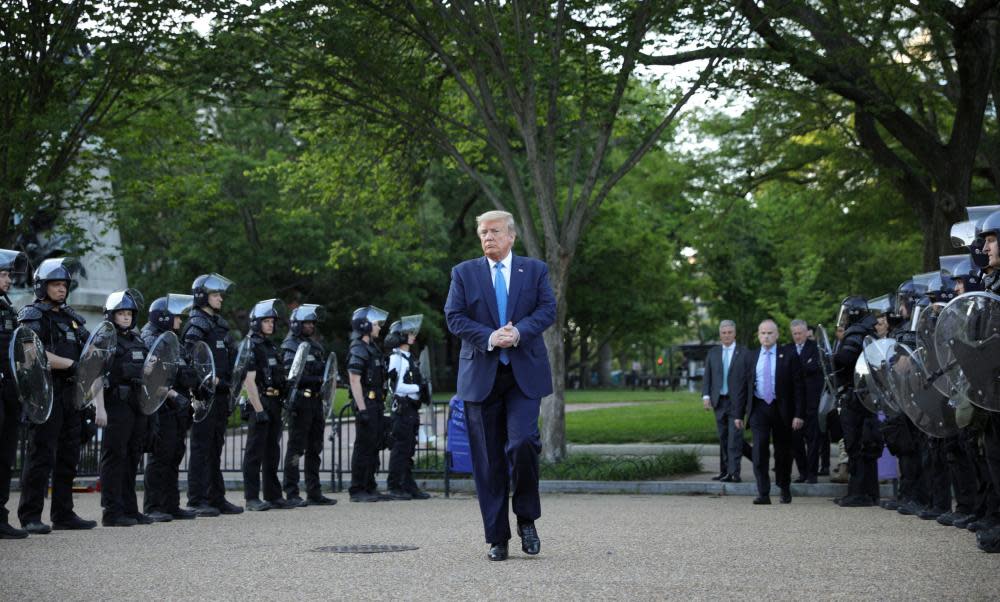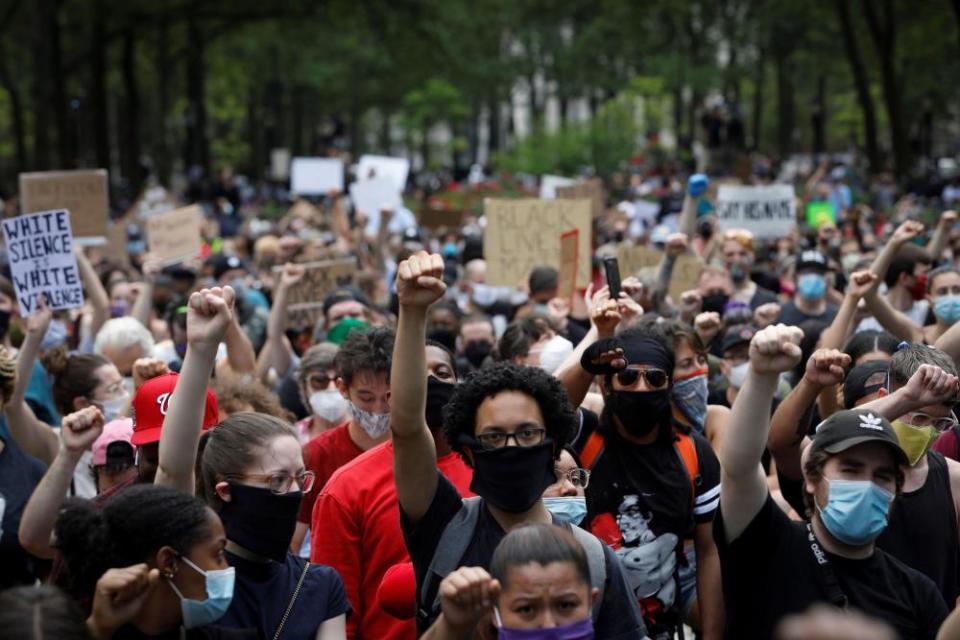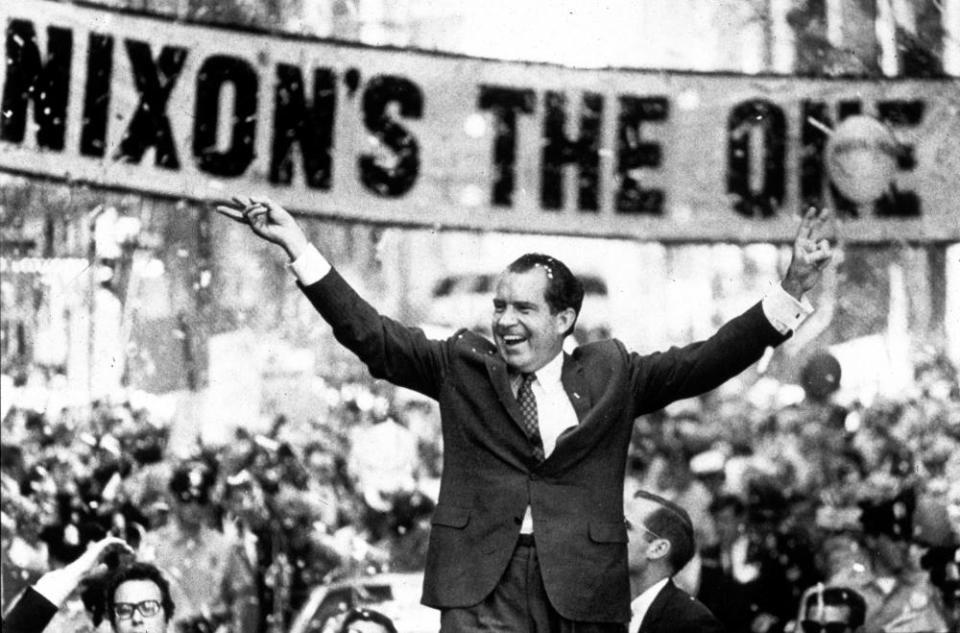Trump reaches for Nixon playbook after protests that have rocked America

They were 48 minutes of mayhem that shook the republic. With a bizarre pageant of riots shields, a Bible and a designer handbag, they also represented what could be Donald Trump’s last best chance of clinging to power.
Related: 'Revolting': Trump condemned for saying George Floyd is praising US economy
Before sunset last Monday, the US president stood in the White House Rose Garden, threatened to turn the American military on the American people and declared: “I am your president of law and order.”
Beyond the perimeter fence, park police and national guard troops fired teargas and chased away peaceful protesters so Trump could cross the road to the fire-damaged St John’s church. Trump was joined by officials including his daughter and senior adviser, Ivanka, clutching a $1,540 handbag. The self-anointed strongman posed for the cameras while awkwardly holding aloft a Bible – or was it the Richard Nixon playbook?
This was the moment that Trump finally found a re-election campaign strategy in his comfort zone. Like his idol Nixon during the turmoil of 1968, he promised to put out the fires in American cities and assuage the fears of white suburbs. It is a framing that portrays Democrats as soft on crime while selling Trump as the national security president – less “Keep America Great” than “Keep America Safe”.
“The Radical Left Democrats new theme is ‘Defund the Police’,” the president tweeted. “Remember that when you don’t want Crime, especially against you and your family. This is where Sleepy Joe is being dragged by the socialists. I am the complete opposite, more money for Law Enforcement! #LAWANDORDER”.

In a year of extraordinary tumult, Trump has found the electoral battleground constantly shifting beneath his feet. Just a few months ago, he was painting the Democrats as radical socialists in thrall to Senator Bernie Sanders, but the party’s nomination was secured by the moderate Joe Biden. He was also trumpeting the strength of the economy, but that narrative was shredded by the coronavirus pandemic – although there was some encouraging news at the end of last week to suggest that US jobs were returning after the lockdown was lifted in many states.
Trump pivoted to blaming China for the virus but polls suggested this gained little traction as voters scrutinised the president’s own sluggish response. But then came the tragedy of George Floyd, an African American man killed when a white Minneapolis police officer pressed his neck with his knee. The subsequent social unrest, the most widespread in half a century, may now have thrown Trump a political lifeline.
The great majority of the protests, including that outside the White House on Monday, have been peaceful, highlighting the injustices of 400 years of slavery and segregation. Some have been met with vicious state-sanctioned force. However, incidents of violence, including ransacking stores and burning police cars, received outsized TV coverage and handed Trump a cultural wedge issue to exploit.
Mandy Jenkins, a journalist, tweeted on Thursday: “My friends and family in rural Ohio honestly believe large swaths of America’s cities are being destroyed by lawless bands of looters who are the same people that are protesting. They get their news exclusively from TV. I don’t think those things are unrelated.”
Like an autocrat in a teetering regime, Trump has staged a massive show of force in the humid capital, with Gen Mark Milley, the chairman of the joint chiefs of staff, strutting the streets in combat fatigues while military helicopters roared overhead. The White House was fenced off, unidentified law enforcement patrolled and troops stood guard at the Lincoln Memorial, a shrine to democracy.
On Wednesday, a Republican party press release was headlined, “President Calls For Law & Order, As Democrats Turn Blind Eye To Violence,” while a Team Trump 2020 fundraising email read criticized members of Biden’s campaign for donating to a fund that helps arrested protesters pay bail in Minnesota.

Never likely to be accused of subtlety, the president himself repeatedly tweeted what may now be his three-word re-election manifesto: “LAW & ORDER!”
The theme is calculated to enflame divisions rather than make new friends. This week James Mattis, the former defense secretary, broke a long silence to describe Trump as a threat to the constitution and the first president in his lifetime who does not try to unite the American people.
But there are doubts over whether such a pitch can work in a country facing its biggest public health crisis since 1918, biggest economic crisis since 1933 and biggest race relations crisis since 1968.
Michael Steele, former chairman of the Republican National Committee, said: “It’s not the smartest strategy in the world, given not just the complexity but the volatility of the nation’s grappling with race and the death of this young man and the response by the police and now the response by the administration.
“So I think that cooler heads will ultimately try to prevail. I doubt they will be successful, at least completely, with Trump because he sees the law-and-order angle as his gate key to open up a new line of conversation. For example, we’re not talking about Covid-19 and the failure of the administration to grapple with the enormity of that crisis.”
Some around Trump compare the moment to 1968, when Nixon ran as the law-and-order candidate after a summer of riots and won the White House. Unlike Nixon, Trump is an incumbent, but seeking to shift blame for the violence to Democratic state governors and city mayors in places such as Minneapolis, New York and Washington.
Nixon vowed to represent the “silent majority”, a phrase Trump tweeted during the past week.

After the Watergate scandal, Nixon became the only US president in history to resign, yet it is his ghost with whom Trump is most likely to commune at dead of night. The 45th president told Fox & Friends on Fox News last month: “I learned a lot from Richard Nixon.”
John Farrell, author of Richard Nixon: The Life, said of Trump: “The best single analogy of Trump’s behavior and Nixon’s comes from May 1971 when the justice department had a massive amount of protesters rounded up and deprived of their civil rights, huddled in stadiums, because Nixon had made the calculation that this would make him look strong to the country. If you are a liberal and you’re worried about this working against Biden, then 71 and 72 are the years that give you nightmares.”
Nixon and Trump came from very different starting points, however. Jamelle Bouie, an opinion columnist at the New York Times, wrote this week: “As former vice-president to Dwight Eisenhower – who led the nation at a time when the white American majority felt culturally and economically secure – Nixon could credibly claim to represent stability in the face of chaos, a steady hand in an uncertain time.
Related: John Kelly says Americans should ‘look harder at who we elect’
“Trump can do no such thing. He built his entire political persona around discord and disruption. Having promised to throw the system into disarray, Trump could not then sell himself as an avatar of order and control. He can sell himself as an avatar of violence … but there’s no evidence that most Americans want that kind of ‘leadership’.”
Recent polls show Biden leading Trump nationally and in swing states, and eating into his advantages among older voters. The president’s law-and-order stance would seem calculated to win them back while setting a political trap for Biden, who must strike a delicate balance between validating anger over police brutality towards African American while condemning violence as a response.
John Zogby, a pollster and author, said: “Trump has seen some serious slippage among white voters over 65. That was a bedrock of his base, so this could be a way: these are people that are far removed from the violence in the streets and fairly one-dimensional in their view of both protesting and violence in the streets, and the most conservative on matters of race.
“Now, will it work? It’s risky and it’s hard to see it working but then he has defied so many rules of engagement. It’s really incumbent now on Joe Biden and the Democrats to win.”

